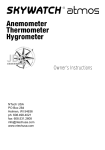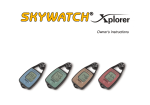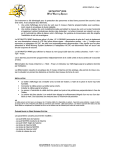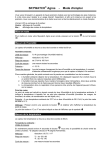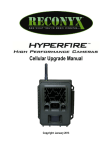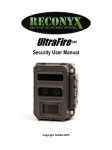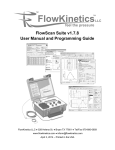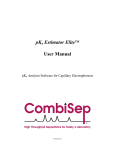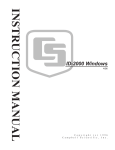Download Old GEOS 9 Manual
Transcript
Owner’s Instructions NTech USA PO Box 882 La Crosse, WI 54602 608.498.4021 (phone) 608.531.2608 (fax) www.ntechusa.com [email protected] Owner’s Instructions SKYWATCH ® You have just acquired a high precision instrument, manufactured using the most up-to-date technology. The Skywatch was designed to handle intense use and extreme conditions. Please take the time to carefully read your instructions so as to understand all the great features this unit has to offer. 123 Buttons Uses : Turn your on by pushing either the wind or mode button. Push the wind button to choose between maximum or average wind speed. Press and hold the wind button to switch the wind speed 1. Button wind measurement unit: km/h, m/s, knots or mph. Push the mode button to choose between current temperature, 2. Button clock WindChill Factor, pressure, pressure historical records and 3. Button mode altitude. Press and hold the mode button to switch temperature unit: ˚C or ˚F. Geos Extreme values of wind speed and temperature can be deleted by pressing both the wind and mode buttons simultaneously. Push the clock button to set the clock timer. Current Temperature : The temperature sensor is located on the left corner, over the All segments display. In the event of severe temperature changes, allow a of the LCD few moments for the sensor to reach the current temperature. Select the current temperature with the mode button. Current temperature is displayed at the bottom of the LCD either in ˚C or ˚F. To change the unit of measurement, press the mode button for 2 seconds. Please note that holding the instrument in your hands for a while may influence the temperature reading. The sensor is very sensitive. Temperature in Celcius and Fahrenheit degree Changing of temperature unit (ºC and ºF) Minimum and Maximum Temperatures : Minimum and Maximum temperatures are permanently displayed. Extreme values will flash on the bargraph. When your instrument is on standby, temperature is measured every thirty (30) minutes, allowing a recording of the extreme values, even when the instrument is turned off. Extreme temperature values can be deleted by pressing both the wind and mode buttons simultaneously. Minimum and maximum temperature measurement displayed with flashing lines on the bargraph Wind-chill Factor : The wind-chill factor is a calculation of the effect of wind on temperature. It portrays an indication of the loss of heat by your body in case of temperatures below 37˚C and the augmentation of the heat with a temperature over 37˚C and wind. For instance, with a 0˚C current temperature and a 40 km/h blowing wind, your body will use as much heat as if it would be exposed to a temperature of -15 ˚C with no wind. This value of -15˚C is called wind-chill factor. Wind-chill factor can be selected by pressing the mode button. The corresponding symbol is then displayed in the bottom of the LDC. Wind-chill factor mode Pressure : The pressure sensor is located inside the instrument. The indicated pressure is the actual pressure at the instrument’s altitude and not the reported pressure at sea level. The pressure can be influenced by 3 main factors: 1. Altitude. Pressure decreases with altitude. In similar meteorological conditions, if pressure is 1013 hPa at the sea level, it will be only 977 hPa at 300m or 794 hPa at 2,000 m. 2. Meteorological conditions. Atmospheric pressure changes according to the weather. During nice weather, pressure at the sea level can reach 1050 hPa and if the weather gets bad, it can go down to 980 hPa. 3. The wind. The wind can exert a pressure on objects that it hits. With a 100 km/h wind blowing, this additional pressure may vary from +/- 10 hPa, depending the position of the instrument. However, for windspeed bellow 30 km/h, this influence is insignificant. Pressure measurement can be selected by pushing the mode button. Pressure in hPa is then displayed at the bottom of Current pressure the LCD. Historical Pressure Record : The instrument automatically records the pressure of the past 3, 6, 9 and 12 hours. The historical pressure record can be selected by pushing the mode button. Pressure in hPa is then displayed at the bottom of the LDC. The pressure from 3 hours ago is represented by the segment number 3. Pressure from 6, 9 and 12 hours ago are represented respectively by segments 6, 9 and 12. Historical pressure record with segments 3, 6, 9 and 12 on the left bargraph Altitude : Altitude is calculated according to barometric pressure. This is why a difference of pressure will influence the indicated altitude. It is necessary to calibrate your instrument before using this function (for instance before mountain climbing or ballooning). Altitude can be selected by pushing the mode button. Altitude is then displayed in meters at the bottom of the LCD. Calibration: Calibration can be done only if the instrument is set in altitude mode. To enter calibration mode, both mode and wind button need to be pushed at the same time. All other information will disappear from the LCD. In this mode, the mode button increases the altitude and the wind button decreases it. Once the reference altitude has been correctly entered, you can leave the calibration mode by pressing both buttons mode and wind at the same time. Altitude Altitude calibration mode Relative humidity : The humidity sensor is located on the left upper side of the display. In the case of a severe humidity change, allow a few moments for the sensor to react and display the new relative humidity level. The relative humidity range goes from 0 to 100%. (0% meaning that the air is completely dry and 100% meaning an air saturated with water.) This limit depends on the quantity of water contained in the air and its temperature. Note that you will need less water in cold air than in warm air to reach 100% relative humidity. The following points have to be taken into consideration when measuring humidity : 1. Relative humidity depends on temperature. By moving the instrument from a warm spot to a cold one, the measured value may differ. 2 Humidity is not homogeneously spread out in the atmosphere so two very close measured areas can give two different readings. 3. The sweat and breath of a person very close to the sensor can influence the results of the measurement. Relative humidity can be selected by pushing the mode button. It is then indicated in % at the lower corner of the display with the symbol % Note: Humidity sensor was calibrated during the assembling of your . It will be possible to re-calibrate it in our factory later on. Relative humidity in percent Dew point : Dew point is calculated by mixing the humidity rate and current temperature. It indicates at what temperature condensation will appear. Dew point can be selected by pushing the mode button. It is then indicated in ˚C or ˚F in the lower corner of the display with the symbol Dew point Current Wind Speed : The impeller at the top is the wind sensor. For accurate measurements, it is necessary for the ball propeller to be wide opened (you can pivot it) and to be aligned with the axis of the wind. The wind vane will help you to find the wind direction. When not in use, it is better to twist the ball propeller into the sphere for optimal protection. Note: if you measure the wind 30˚ off the wind axis, the result will be wrong of only by 2%. Current wind speed is permanently displayed in the middle of the LCD. By pushing on the wind button for more than 2 seconds, you can switch your unit of measurement. Optional units of measurement include: MPH, KPH, knots, and m/s The Beaufort scale on the left of the Beaufort scale display always indicates the instant wind Instant windspeed, here 5.1km/h speed. The speed displayed is averaged over 2 seconds. Average and Maximum Wind Speed : The average wind speed calculation is based on measurements made over the past 60 seconds. So after 70 seconds of use, measurements taken during the first ten seconds will not be taken into consideration to calculate the average wind speed. This balanced measurement mode allows an accurate display of the windspeed, without being influenced by the wind speed irregularities. Average and maximum wind speed can be selected by pushing the wind button. These speeds are displayed in the top of the LCD, Maximum Average windspeed windspeed with a AV symbol for average wind speed and MAX symbol for maximum wind speed. Maximum wind speed can be deleted by pressing the wind and mode buttons simultaneously. Standby : The instrument turns itself to standby after 3 minutes without touching any buttons. In the stand by mode, only the clock is displayed. A pressure on a button and the instrument turns on. Clock Timer: Standby mode The clock is displayed only in standby mode. Press and hold the middle button for 1-2 seconds to set the clock. The mode button increases minutes and the wind button increases hours. Another push on the middle button sets the instrument back in normal mode. Press and hold the middle button to switch the clock between 24 or 12 hours - with AM and PM indication displayed. Note: The clock setting can not be done when the is in standby. Ball propeller: The ball propeller has to be wide opened and aligned with the wind axis in order to get accurate windspeed measurement. Use the wind vane for a good alignment with the wind. After using your instrument, twist the ball propeller into the sphere for optimal protection. The ball propeller can be popped out but for replacement only. This operation may affect the strength of the plastic so we do not recommend it. Compass : The features a high precision, Swiss needle compass. Wind Vane : The Wind vane is located just below the ball propeller. Turn the instrument so that the wind blows on the wind vane and indicates wind direction. Then align your instrument with the axis of the wind for an accurate reading. Wind direction can be determined by using the compass in conjunction with the wind vane. A turning wind vane means that it is not well aligned with the wind axis. Be aware that holding the instrument in front of you may disturb the airflow through the wind vane. Batteries : The is powered by a 3V type CR2032 Lithium battery,. The features an extra battery that allows for convenient replacement at any time and place. Battery replacement : Unscrew the cover on the back of the instrument. Insert the battery on the bottom, positive side (+) facing you. A second replacement battery HAS to be put on the top of first battery and HAS to be inserted with negative side (-) facing you - the + side against the + side. Screw the cover back with the 2 screws M2,5 x 5. Maintenance advises : We have used only electronic components that resists to high temperature but we still strongly recommend that you do not expose your instrument to temperatures above 65˚C. This instrument is weatherproof but not waterproof. Do not submerge it. In order to avoid dirt around the impeller axis, we strongly recommend to twist the ball propeller into the sphere when not in use. Despite the rugged casing, avoid dropping your instrument and exposing it to shock. This limited warranty shall be in effect for one year after the date of purchase by the original consumer purchaser. During this limited warranty period, JDC Electronic SA will repair or replace without charges any defective product with a comparable product. This limited warranty will not apply to any instrument that has been misused, improperly installed, repaired, altered or which has been the subject of any negligence or accident. The speed measurement principle of the SKYWATCH ® Geos is based on magnetic transmission. The turning impeller creates a magnetic field that is detected by the SKYWATCH ® Geos (JDC Electronic SA patent). If the SKYWATCH ® Geos is close to another magnetic field (from a computer, electronic appliance, etc...), it may display unexpected values but only if the impeller is not turning. This is not effecting the normal use of the SKYWATCH ® Geos. Conversion table of several Measurement Units Beaufort 1 2 3 4 5 6 7 8 9 10 11 12 knots 1 - 3 4 - 6 7 - 10 11 - 16 17 - 21 22 - 27 28 - 33 34 - 40 41 - 47 48 - 55 56 - 63 >64 km/h 1 5 6 - 11 12 - 19 20 - 28 29 - 38 39 - 49 50 - 61 62 - 74 75 - 88 89 - 102 103 - 117 >118 1 4 8 13 19 28 32 39 47 56 65 mph - 3 - 7 - 12 - 18 - 24 - 31 - 38 - 46 - 55 - 64 - 73 >74 m/s 1 - 2 2 - 3 4 - 5 6 - 7 8 - 10 11 - 13 14 - 16 17 - 20 21 - 24 25 - 28 29 - 32 >33 fps 1 4 5 - 10 11 - 17 18 - 25 26 - 34 35 - 44 45 - 55 56 - 67 68 - 80 81 - 92 93 - 106 >107 Technical Specifications Accuracy Current wind speed ±4% Average wind speed ±4% Current ±0.5 °C temperature ±(0.9 °F) Resolution Minimum 0.1 knots 0.1 mph 0 0.1 km/h 0.1 m/s 0.1 knots 0.1 mph 0 0.1 km/h 0.1 m/s 1 °C -30 °C 1 °F -22 °F Maximum 108 knots 125 mph 202 km/h 56 m/s 108 knots 125 mph 202 km/h 56 m/s 50 °C 122 °F Sampling Response time 1 sec 3 sec — — 1 sec 5 min1) Wind-chill - 2) 1 °C — — 1 sec — factor 1 °F Pressure3) ±2 mbar 1 mbar 300 mbar 1100 mbar 1 hour — Altitude ±2 m4) 1m -500m 8000m — — 1) measured in still air 2) based on a formula provided by the Midwestern Climate Center, USA: wc = 91.4 - (0.474677 - 0.020425 v + 0.303107 sqrt(v)) (91.4-T) where wc = wind-chill factor (°F), v = wind speed (mph) and T = temperature (°F) 3) absolute pressure. (Pressures 3, 6, 9, 12 hours ago are displayed.) Hygrometer part Temperature use -10°C...50°C Precision Resolution Minimum Maximum Sampling ±3 %rH 1 %rH 0 %rH 99 %rH 1,5 sec Response time 5 min Limited warranty : This limited warranty shall be in effect for one year after the date of purchase by the original consumer purchaser. During this limited warranty period, JDC Electronic SA will repair or replace without charges any defective product with a comparable product. This limited warranty will not apply to any instrument that has been misused, improperly installed, repaired, altered or which has been the subject of any negligence or accident. The speed measurement principle of the SKYWATCH® Geos is based on magnetic transmission. The turning impeller creates a magnetic field that is detected by the SKYWATCH® Geos (JDC Electronic SA patent). If the SKYWATCH® Geos is close to another magnetic field (from a computer, electronic appliance, etc...), it may display unexpected values but only if the impeller is not turning. NTech USA PO Box 284 Holmen, WI 54636 608.498.4021 (phone) 608.531.2608 (fax) www.ntechusa.com [email protected]










